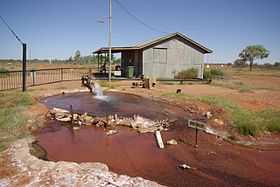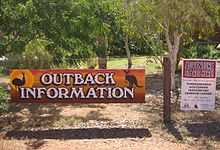Thargomindah
| Thargomindah Queensland | |||||||
|---|---|---|---|---|---|---|---|
 Outback roadhouse of Thargomindah | |||||||
 Thargomindah | |||||||
| Coordinates | 28°00′0″S 143°49′0″E / 28.00000°S 143.81667°ECoordinates: 28°00′0″S 143°49′0″E / 28.00000°S 143.81667°E | ||||||
| Population | 203 (2006)[1] | ||||||
| Postcode(s) | 4482 | ||||||
| Location |
| ||||||
| LGA(s) | Shire of Bulloo | ||||||
| State electorate(s) | Warrego | ||||||
| Federal Division(s) | Maranoa | ||||||
| |||||||
Thargomindah /ˈθɑrɡoʊmɪndə/ is a town in South West Queensland, Australia on the Adventure Way, approximately 1,100 kilometres (680 mi) west of the state capital, Brisbane, 200 kilometres (120 mi) west of the town of Cunnamulla and within a relatively short distance to Cameron Corner . Thargomindah is the administrative centre for the Shire of Bulloo and lies on the Bulloo River. At the 2006 census, Thargomindah had a population of 203.[1]
There are all essential supplies at Thargomindah. The service station hosts also a good general store, fast food, hardware, tyre repairs and mechanics. Camping and outback supply can be found here and water reservoirs should be filled for the last time with bore mineral drinking water before heading west.
Facilities
An information centre is located in the historic mud brick building of the former hospital. The collection and arrangement of antique household items is a local attraction. The present hospital, located on Dowling Street, is run by Robert Wall, the Director of Nursing. Sports grounds, caravan park and the powerhouse demonstration are available. The nearby river offers trees and water biotopes in the vicinity. Thargomindah has a public library open to the general public.
Heritage listings
Thargomindah has a number of heritage-listed sites, including:
- Bulloo River: Dr Ludwig Becker's Grave[2]
- Nappa Merrie Station: Burke and Wills Dig Tree[3]
- Wilson Street: Noccundra Hotel[4]
Water

Thargomindah has a pressurised hot spring from a bore into the Great Artesian Basin and has produced hydroelectric power from the basin in the past. After 2 years of drilling, a good supply of water was found in 1893. The temperature was 86 °C (187 °F). In 1924, it was recorded that the bore had a daily output of 2,500 cubic metres (88,000 cu ft) and today of 1,300 cubic metres (46,000 cu ft) at 84 °C (183 °F). There is a plentiful water supply for the population and the arid area available for irrigation in front and backyards and public warm showers are provided.
History

The town was first settled in the 1860s at a crossing of the Bulloo River.[5] A post office was established in 1870 and a telegraph line connected the town to Cunnamulla in 1881. The 1890s saw the town prosper as the service and administrative centre of a pastoral district.[5]
One of the first towns in Australia,(after Duck Reach in Launceston Tasmania 1895) third in the world, after Paris and London [citation needed], Thargomindah produced hydroelectric power from 1898 until 1951, which then was taken over by diesel generators until 1988. The town was finally connected to the national power grid via Cunnamulla. The old bore was source of energy when electric street lights where lit and coupled to a turbine driven by the bore's natural water pressure. The generator was taken from a unit powered by a steam engine and purchased by the Bulloo Divisional Board becoming the first municipality owned power plant. The power station is still operating with a daily opening to the public. It is believed to be the oldest, still workable unit in Australia and possibly in the world.[citation needed]
Transport
Thargomindah Airport is located near the township. A railway extension to the town was planned for many years, however it never eventuated. The railway did reach Cunnamulla in 1898 and to Quilpie in 1917.[5]
Climate
Thargomindah has a hot semi-arid climate.
| Climate data for Thargomindah | |||||||||||||
|---|---|---|---|---|---|---|---|---|---|---|---|---|---|
| Month | Jan | Feb | Mar | Apr | May | Jun | Jul | Aug | Sep | Oct | Nov | Dec | Year |
| Record high °C (°F) | 48.8 (119.8) |
46.0 (114.8) |
43.8 (110.8) |
38.9 (102) |
32.2 (90) |
30.4 (86.7) |
28.5 (83.3) |
36.3 (97.3) |
39.2 (102.6) |
41.2 (106.2) |
45.4 (113.7) |
45.0 (113) |
48.8 (119.8) |
| Average high °C (°F) | 38.5 (101.3) |
36.0 (96.8) |
33.5 (92.3) |
29.5 (85.1) |
23.8 (74.8) |
20.0 (68) |
20.1 (68.2) |
22.9 (73.2) |
27.8 (82) |
31.1 (88) |
33.8 (92.8) |
36.4 (97.5) |
29.5 (85.1) |
| Average low °C (°F) | 25.5 (77.9) |
24.0 (75.2) |
21.2 (70.2) |
16.6 (61.9) |
10.6 (51.1) |
7.5 (45.5) |
6.7 (44.1) |
8.3 (46.9) |
12.8 (55) |
16.6 (61.9) |
20.6 (69.1) |
23.0 (73.4) |
16.1 (61) |
| Record low °C (°F) | 17.2 (63) |
12.3 (54.1) |
9.4 (48.9) |
6.5 (43.7) |
1.0 (33.8) |
−0.8 (30.6) |
−0.9 (30.4) |
0.1 (32.2) |
4.7 (40.5) |
6.2 (43.2) |
9.7 (49.5) |
13.7 (56.7) |
−0.9 (30.4) |
| Precipitation mm (inches) | 39.1 (1.539) |
47.9 (1.886) |
45.5 (1.791) |
17.5 (0.689) |
14.4 (0.567) |
16.7 (0.657) |
13.6 (0.535) |
8.0 (0.315) |
9.8 (0.386) |
14.1 (0.555) |
40.7 (1.602) |
30.3 (1.193) |
300.4 (11.827) |
| Avg. precipitation days | 3.6 | 4.5 | 4.4 | 1.4 | 2.8 | 3.9 | 3.5 | 2.0 | 2.6 | 3.4 | 5.5 | 4.4 | 42.0 |
| Source: [6] | |||||||||||||
References
- ↑ 1.0 1.1 Australian Bureau of Statistics (25 October 2007). "Thargomindah (L) (Urban Centre/Locality)". 2006 Census QuickStats. Retrieved 2009-07-25.
- ↑ "Dr Ludwig Becker's Grave (entry 16122)". Queensland Heritage Register. Queensland Heritage Council. Retrieved 2013-07-07.
- ↑ "Burke and Wills Dig Tree (entry 15847)". Queensland Heritage Register. Queensland Heritage Council. Retrieved 2013-07-07.
- ↑ "Noccundra Hotel (entry 15136)". Queensland Heritage Register. Queensland Heritage Council. Retrieved 2013-07-07.
- ↑ 5.0 5.1 5.2 Environmental Protection Agency (Queensland) (2002). Heritage Trails of the Queensland Outback. State of Queensland. pp. 114–115. ISBN 0-7345-1040-3.
- ↑ "Climate statistics for Thargomindah". Bureau of Meteorology. Retrieved 13 April 2013.
External links
![]() Media related to Thargomindah, Queensland at Wikimedia Commons
Media related to Thargomindah, Queensland at Wikimedia Commons